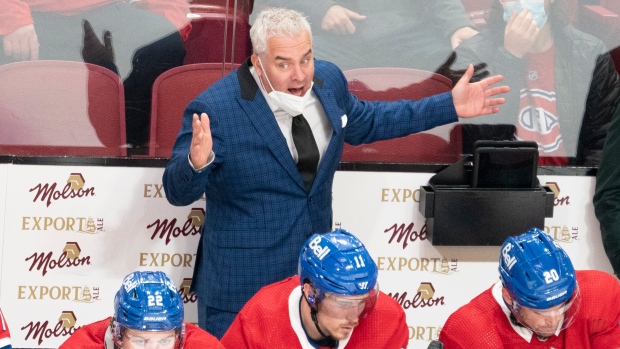Oct 21, 2021
Pressure already mounting in Montreal
Four games represent a small sample size, but the Canadiens’ inability to win and sustain the offensive zone points to this not being a typical losing streak, Travis Yost writes.
By Travis Yost

The Montreal Canadiens, as much as any team in the league, wanted a hot start to the regular season. How better to push aside concerns that last year’s momentum-fuelled playoff run was merely a combination of incredible puck luck and outstanding goaltending?
Their start has been anything but hot. The Canadiens – already undermanned with the losses of Shea Weber, Carey Price, and Paul Byron – have dropped the first four games of the year. Sometimes records in short windows don’t explain how well or how poorly a team is playing.
In this case, the four losses may be understating how poor Montreal has been. The team has been outscored 15-3 over those first four games, a wicked combination of converting on just 2.6 per cent shooting and 13 per cent shooting against. Unless Montreal can start outshooting teams on a 5:1 basis, it’s a gap that will guarantee a place in the draft lottery.
Shooting percentages are fleeting, and at some point, the bounces will start to manifest on both ends of the ice. The question: Will it matter? Because much more problematically, the lion’s share of these games are being played with Montreal chasing the puck. That’s created additional defensive pressure, but in Montreal it’s their total inability to win and sustain the offensive zone that’s rendered them ineffective to start the year (via HockeyViz):

The Canadiens were a middling offensive team at even strength last season, finishing 20th in goal scoring and 10th in expected goal scoring – the latter being driven by higher shot volumes, albeit from less dangerous areas of the ice.
They were also an average team on the man advantage, finishing 17th in rate power-play scoring. You can get by with average offensive bite and great defensive structure; this appears a far cry from what the Canadiens had even compared to last year’s regular season baseline.
One of the things I was curious about was where the weakness in the lineup was manifesting. Four games of data is still quite limited, but I was curious to see where the shifts were in performance, particularly considering the lineup reconstruction this organization oversaw during the summer.
If we look at each player’s rate expected goal advantage season-over-season, we see breakdowns across the board. And it’s happening on two fronts. The returning players from the lineup, save Jonathan Drouin, are all down year-over-year. The player additions made by Marc Bergevin over the summer, generally through free agency and the trade market, have not been as effective as the displaced parts of the roster from a summer ago:

The fact that most skaters are underwater by a considerable margin on rate expected goals, a measure blind to goaltending performance and that heinous 86 per cent stop rate, is concerning. Even over four games.
One reason you saw veteran forward Brendan Gallagher speaking to adversity on the ice is simple – he’s been around the league long enough to know this isn’t a typical losing streak. The Canadiens are being decisively outplayed, and Gallagher – with his 600-plus games of NHL experience – knows it.
Said another way: Montreal sorely needs more from Jake Allen and Sam Montembeault, but that alone is not going to right the ship for Dominique Ducharme’s team.
Montreal will have a pair of opportunities, starting Thursday night with some fresh new line combinations, to right the ship at home. If they cannot take care of business at the Bell Centre, a four-game trip road trip awaits them on the west coast.
Let’s see how Montreal’s young core handles the mounting pressure.
Data via Natural Stat Trick, Evolving Hockey, NHL.com, Hockey Reference

